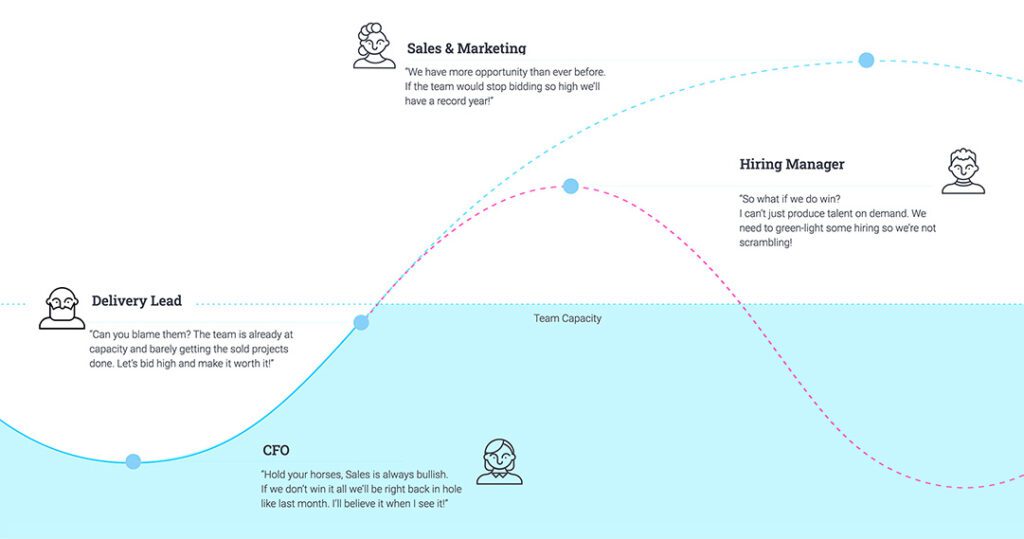Run a Reactive Digital Services Firm? Every Employee Plays a Role in Forecasting
Digital services firms are in a constant cycle of reactivity when they don’t forecast well and often.
They can’t predict in advance whether they’ll have enough or too much work for their staffed resources. The result is the all-too-familiar “too much work, not enough work” roller coaster. They either have too many people and not enough work because they didn’t proactively spot dips in the sales pipeline. Or, they have too few people and too much work because sales, delivery, and resourcing weren’t communicating well.
This reactivity is painful for everyone — employees, leaders, and the business. Let’s be honest, it sucks to feel reactive, uncertain, and continually rely on heroic efforts to deliver quality work on time. It burns employees out, hurts your agency culture, and creates tension between teams.
Every single one of your employees — including sales reps, project managers, resource planners, and other individual contributors, has a role to play in forecasting. Each person has at least one data point that impacts whether you can run accurate, real-time forecasts and use them to inform strategic planning. It’s up to you, as an agency leader, to enable and empower your people to participate in the forecasting process.

Each employee’s role in forecasting
Forecasting itself isn’t overly complicated or technical. What is difficult is adopting the habits necessary to tend to forecasts. After all, forecasts are only accurate and useful when you have access to up-to-date agency data.
Keeping data updated depends on your people. This data habit shouldn’t fall on the shoulders of just one or two employees. If each of your employees spends a little time each day keeping their data inputs updated, the agency can produce better forecasts that paint a clearer picture of the future.
Below are examples of how different employees can impact agency forecasts:
- Individual contributor (e.g., developer, designer, copywriter): These are the employees who know based on experience what it takes to get work done. If they believe the work required to do a good job will take them more or less time to complete than allotted, they should communicate it to their project manager. The same goes for any adjustments to their available capacity (e.g., upcoming PTO, holidays), which they need to communicate to resource managers. A regular and transparent line of communication between individual contributors, project managers, and resource managers is critical to accurate forecasts.
- Project managers and delivery leads: Project managers and delivery leads should regularly review and update project plans to account for things they know need to change. For example, they should update project details if an employee tells them they need more time to complete a particular phase of work or if there’s a significant change in scope.
- Resource managers: Resource managers should regularly review and update resource plans to account for schedule or team changes that impact workloads (e.g., it’s taking an employee longer to complete work than initially planned).
- Sales reps: Sales reps should update project details in the CRM each time something changes with a prospective client’s timing, scope, or needs. These details impact pricing and resourcing, which are both foundational to resource capacity and revenue forecasts.
- Leaders: The most important forecasting habit of a leader is to nurture a work environment that fosters collaboration and communication and empowers employees at all levels of the agency to participate. We also recommend investing in technology that creates a shared perspective and regularly review forecasts to inform business planning 😉.
Digital services companies need to get all of the data and information out of employees’ heads and individual spreadsheets and into a system that creates a shared perspective — creating opportunities for conversations that will change behavior and improve company operations.

Better communication inspires smarter planning
Best practices encourage you to know what your resource plan and revenue and sales projections are going to be at least six weeks in advance. This requires visibility into the sales pipeline and updated CRM data and project plans (which, again, depends on the habits of your people!). An accurate resource plan helps you better understand your resource capacity forecast, enabling a better revenue forecast. Each of these pieces is critical to making smart and strategic business decisions.
Most importantly, the proactive nature of forecasting enables valuable conversations across teams. For example, resource managers can spot when there isn’t enough work coming down the pipeline to hit utilization targets. Project management or delivery can identify when their team is overbooked and concerned they can’t deliver projects on time or at the quality they need to. This proactive communication can trigger action-oriented discussions between teams, including:
- What can we do to fill gaps in the sales pipeline? Do we need to invest more in marketing?
- How are we going to ensure all of the work gets done? Are we just going to buy pizza and push everyone to work overtime — or is it time to hire new employees or contractors?
- How can we set better timing expectations upfront with new clients so we’re not overpromising and under-delivering?
After implementing Parallax, one of our customers created a new internal process to review forecasts together during regularly scheduled meetings. These meetings bring together key cross-functional leaders, so they can proactively review forecasts and spot concerning trends, all using real-time, reliable data and forecasts in Parallax. The meetings foster better communication between teams and enable the agency to take proactive action on trends they would’ve previously missed without Parallax — preventing them from falling into a chaotic, reactive cycle.
Just as it did for the customer we detailed above, regular communication informed by forecasts can enable your agency to make smart and proactive decisions that stabilize your workload and create a better experience for employees and customers. Employees aren’t as overworked, overwhelmed, and worried. Customers get better work quality because it’s less rushed and done by happier and healthier employees.

The people impact of better forecasting
Agencies create reactive environments, emotional situations, and misaligned teams without forecasting. When employees work for a reactive agency, they often feel burnt out or uncertain. How could I possibly continue working at this pace? Or – Is there going to be enough work for me next month, or is my job at risk?
Agencies that treat their employees as cogs in the machine — just there to churn out work at whatever rate the agency requires them to — won’t retain talent or develop the habits it needs to grow.
The solution? Smarter forecasting with everyone in the agency contributing data inputs. When agency leaders empower their people to positively impact the agency and the people around them, the entire business benefits. Empower your employees to speak up and contribute to agency forecasts, and you’ll be a more strategic agency with happier employees.
Parallax can help you create a shared perspective and adopt the forecasting habits needed to grow. Set up some time to see how Parallax could work for your agency.
Was this article helpful in thinking about forecasting at your agency? Subscribe to get updates delivered straight to your email.
